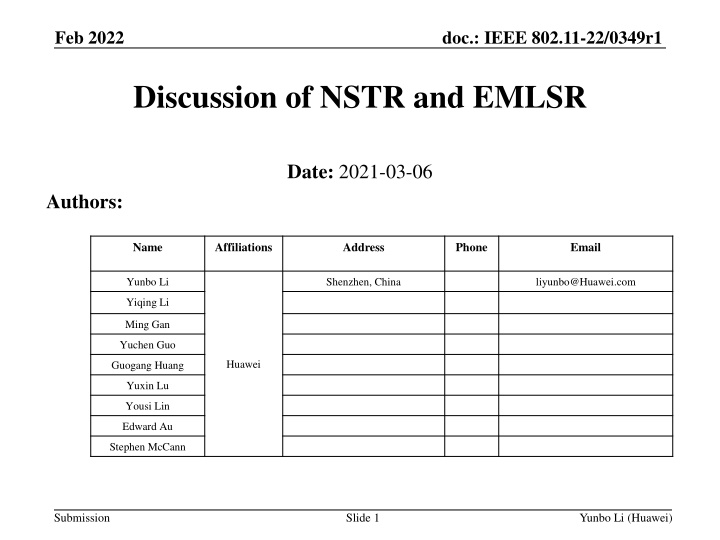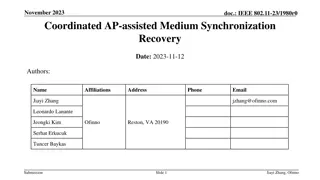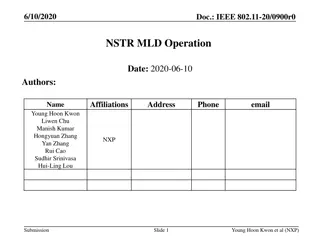IEEE 802.11-22/0349r1 Feb. 2022 Discussion of NSTR and EMLSR
Discussion on the introduction of eMLSR in IEEE 802.11-22/0349r1 compared to other modes like NSTR, with a proposal to make eMLSR support mandatory on AP MLD side due to its significant gains and importance in MLO. The presentation also highlights the performance comparison between NSTR and EMLSR, addressing issues such as waiting time, interference constraints, switch delays, and frequency diversity. Overall, emphasizing the relevance and benefits of eMLSR in 11be technology.
Download Presentation

Please find below an Image/Link to download the presentation.
The content on the website is provided AS IS for your information and personal use only. It may not be sold, licensed, or shared on other websites without obtaining consent from the author.If you encounter any issues during the download, it is possible that the publisher has removed the file from their server.
You are allowed to download the files provided on this website for personal or commercial use, subject to the condition that they are used lawfully. All files are the property of their respective owners.
The content on the website is provided AS IS for your information and personal use only. It may not be sold, licensed, or shared on other websites without obtaining consent from the author.
E N D
Presentation Transcript
doc.: IEEE 802.11-22/0349r1 Feb 2022 Discussion of NSTR and EMLSR Date: 2021-03-06 Authors: Name Affiliations Address Phone Email Yunbo Li Shenzhen, China liyunbo@Huawei.com Yiqing Li Ming Gan Yuchen Guo Huawei Guogang Huang Yuxin Lu Yousi Lin Edward Au Stephen McCann Submission Slide 1 Yunbo Li (Huawei)
doc.: IEEE 802.11-22/0349r1 Feb 2022 CID 5773 CID 5773Laurent Cariou 35.3.15 Commenter Section Page.Line 281.17 Comment eMLSR has been introduced a bit late compared to other modes like NSTR and has therefore been introduced as optional. However, support for operation with non-AP MLD with the other main modes is mandatory at the AP MLD side (NSTR, STR). It would make sense that all the main modes are actually mandatory supported on all AP MLDs. On top of that, eMLSR has shown significant gains and is clearly a very important features for MLO in 11be. Also complexity to support eMLSR for an AP MLD that already supports operation for NSTR or STR non-AP MLD is relatively minor. Proposed Change Make eMLSR support mandatory on AP MLD side. Resolution Submission Slide 2 Yunbo Li (Huawei)
doc.: IEEE 802.11-22/0349r1 Feb 2022 Background A pair of links on which a regular AP MLD operates is mandate to be STR. A pair of links on which a non-AP MLD operates could be STR, NSTR, MLSR, or EMLSR, depending on the cost, size, frequency gap between these two links and so on; MLSR can obtain performance gain by using link selection according to the traffic load and link quality, but it has worse performance on throughput and latency than NSTR and EMLSR; This presentation focuses on NSTR and EMLSR and provides their performance comparison. Submission Slide 3 Yunbo Li (Huawei)
doc.: IEEE 802.11-22/0349r1 Feb 2022 Performance loss compared with STR NSTR For UL channel access, there may exist waiting time on one link for another link if an NSTR non-AP MLD intends to transmit on these two links simultaneously; When an AP MLD schedules the UL/DL transmission for an NSTR non-AP MLD, cross link interference constraint should be taken into account Blindness exists on one link due to the transmission on another link EMLSR Overhead of initial control (MU-RTS/CTS, or BSRP/BSR) Overhead of switch delay between receiving mode and listen mode Blindness exists on one link due to the transmission on another link Blindness exists during the frequent switch Lack of frequency diversity resulting from more than one link Submission Slide 4 Yunbo Li (Huawei)
doc.: IEEE 802.11-22/0349r1 Feb 2022 Comparison between NSTR and EMLSR NSTR EMLSR MIMO Flexible to be SISO or MIMO Mandatory to support MIMO RF switch No Frequent Peak throughput (1+1 for NSTR; 2*2 for EMLSR) Higher because of the frequency diversity Lower due to Overhead of Initial Control and switch delay Interference among those streams, resulting in low MCS Sounding overhead Whether UL transmission on link 1 will cause blindness on link2 or not? No for single short packet (<72us) ; Yes for long packet ( 72us) Yes Whether DL transmission on link 1 will cause blindness on link2 or not? No for most cases because BA is shorter than MediumSyncThreshold in many cases Yes Is simultaneous transmission allowed on more than link? Yes No Probability for blindness Relative Low Relative high Submission Slide 5 Yunbo Li (Huawei)
doc.: IEEE 802.11-22/0349r1 Feb 2022 Setting of System Level Simulation Parameters Value # of AP MLDs 2 # of affiliated APs for each AP MLD 2 # of associated non-AP MLDs for each AP MLD 8 coverage of BSS 10 m * 10 m Distance between two AP MLDs 30 m BW 80 MHz MCS 11 Traffic direction UL + DL DL PPDU type MU-MIMO (4*4) UL PPDU type MU-MIMO for TB PPDU (4*4); SISO for NSTR EDCA; 2*2 MIMO for EMLSR EDCA MPDU size 1500 Bytes for throughput simulation, 200Bytes for delay simulation Switch delay of EMLSR 128 us Blindness period 5.484 ms Submission Slide 6 Yunbo Li (Huawei)
doc.: IEEE 802.11-22/0349r1 Feb 2022 Simulation Results of Throughput MPDU size = 1500Bytes; Max number of aggregation = 256 23.1% for Aggr=4 13% for Aggr=8 7.5% for Aggr=16 16.7% for Aggr=32 12.5% for Aggr=64 10.4% for Aggr=128 100% for Aggr=64 100% for Aggr=128 94% for Aggr=256 37.6% for Aggr=64 31.3% for Aggr=128 28.2% for Aggr=256 Traffic load of EMLSR: 14.8% for Aggr=2 7.7% for Aggr=4 4.3% for Aggr=8 8.5% for Aggr=1 Traffic load of NSTR: 5.7% for Aggr=2 4.1% for Aggr=4 2.5% for Aggr=8 12.4% for Aggr=4 7.6% for Aggr=8 5.6% for Aggr=16 15.1% for Aggr=32 13% for Aggr=64 12.5% for Aggr=128 100% for Aggr=64 100% for Aggr=128 100% for Aggr=256 39% for Aggr=64 37.6% for Aggr=128 36% for Aggr=256 3.1% for Aggr=1 Note 1: Aggr=n means there are n MPDUs in an A-MPDU. Note 2: the traffic loads are rough estimations, not accurate loads Note 3: OBSS load refers to traffic load since two BSSs have the same traffic load in simulation Submission Yunbo Li (Huawei) Slide 7
doc.: IEEE 802.11-22/0349r1 Feb 2022 Simulation Results of Throughput For simulation in previous slide, interference level between two APs is about -66dBm; Two more simulations are provided with different interference levels between APs. Interference level between two APs is about -76dBm Submission Yunbo Li (Huawei) Slide 8
doc.: IEEE 802.11-22/0349r1 Feb 2022 Simulation Results of Throughput For simulation in previous slide, interference level between two APs is about -66dBm; Two more simulations are provided with different interference levels between APs. Interference level between two APs is about -56dBm Submission Yunbo Li (Huawei) Slide 9
doc.: IEEE 802.11-22/0349r1 Feb 2022 Simulation Results of Delay MPDU size = 200 Bytes, Max number of aggregation = 256; MPDU life time = 20ms Submission Slide 10 Yunbo Li (Huawei)
doc.: IEEE 802.11-22/0349r1 Feb 2022 Summary A pair of links on which a non-AP MLD operates is not STR, there are three possible modes: NSTR, MLSR and EMLSR. Based on the performance analysis, NSTR has much better performance compared with EMLSR Given that NSTR and MLSR are mandatorily supported at AP MLD side and they provide flexibility to the non-AP MLD (One is for good performance, the other is for low cost ), it is not reasonable to mandate EMLSR at AP MLD side. Submission Slide 11 Yunbo Li (Huawei)
doc.: IEEE 802.11-22/0349r1 Feb 2022 Straw Poll Do you agree to resolve CID 5773 as below? CID 5773Laurent Cariou 35.3.15 Commenter Section Page.Line 281.17 Comment eMLSR has been introduced a bit late compared to other modes like NSTR and has therefore been introduced as optional. However, support for operation with non-AP MLD with the other main modes is mandatory at the AP MLD side (NSTR, STR). It would make sense that all the main modes are actually mandatory supported on all AP MLDs. On top of that, eMLSR has shown significant gains and is clearly a very important features for MLO in 11be. Also complexity to support eMLSR for an AP MLD that already supports operation for NSTR or STR non-AP MLD is relatively minor. Proposed Change Make eMLSR support mandatory on AP MLD side. Resolution Rejected. Base on the performance analysis in doc 11- 22/0349r0, NSTR is the best, EMLSR is the second, and MLSR is the worst. Since NSTR and MLSR already been mandated at AP MLD side, mandating EMLSR at AP MLD side will add too many options and the complexity to AP MLD side. Submission Slide 12 Yunbo Li (Huawei)























